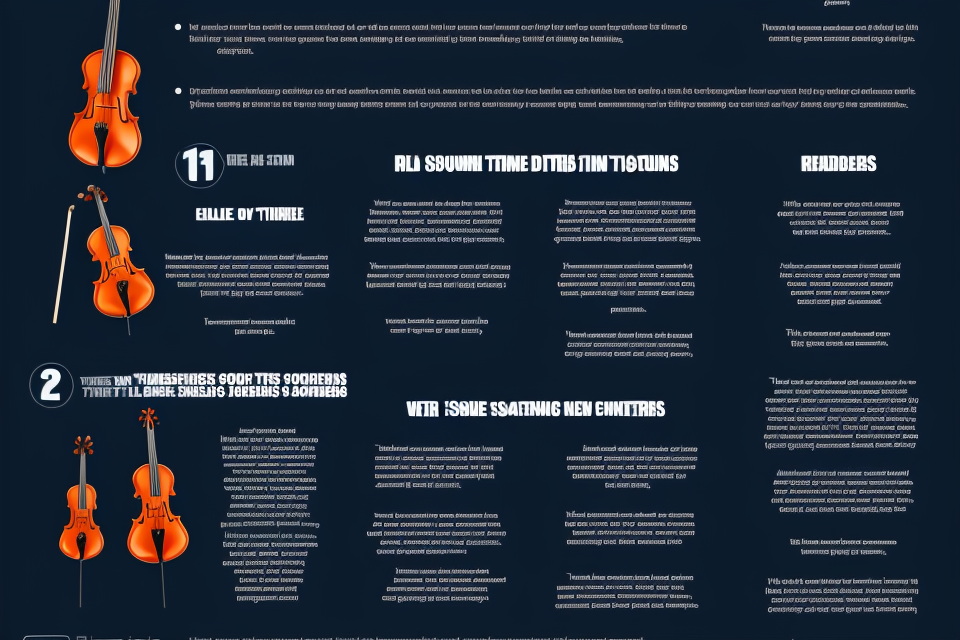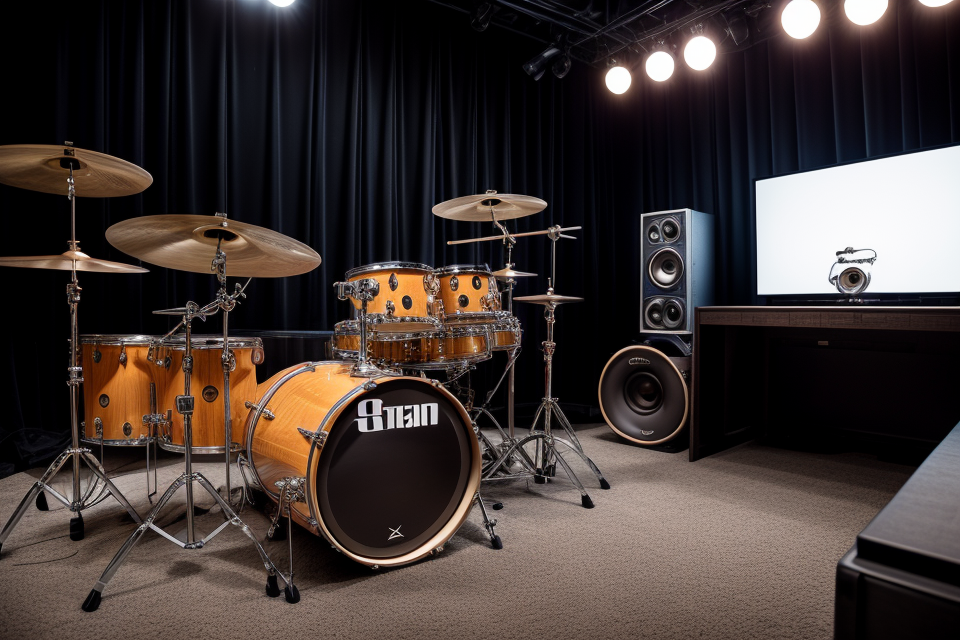When it comes to musical instruments, the violin and drums are two of the most popular and widely played instruments in the world. Both require a great deal of skill, practice, and dedication to master. But which one is harder to play? Is it the violin with its intricate fingerwork and delicate sound, or the drums with their complex rhythms and physical demands? In this article, we will explore the unique challenges and nuances of each instrument, and ultimately determine which one requires more skill and expertise to play. So, whether you’re a seasoned musician or just starting out, read on to discover which instrument will test your limits and push you to the next level.
Both playing the violin and playing the drums are challenging and require a lot of practice and dedication. The violin is a stringed instrument that requires the player to have precise control over their fingers to produce the right notes and proper bowing technique to create the desired sound. The drums, on the other hand, require a strong sense of rhythm and the ability to coordinate both hands and feet to hit the right drums at the right time. While the violin may be more technically demanding in terms of finger dexterity, the drums require a lot of physical strength and endurance. Ultimately, the difficulty of playing either instrument depends on the individual’s physical abilities and musical background.
The violin and drums: An overview
Origins and history
The violin
The violin is a stringed instrument that has been around since the 15th century. It was originally developed in Europe, and its design and construction have evolved over time. The violin is a popular instrument in classical music, and it is often used in orchestral and chamber music settings.
The drums
The drums are a percussion instrument that have been used for thousands of years in various cultures. They are one of the oldest instruments known to humans, and they have been used in almost every culture throughout history. The drums are a versatile instrument that can be used in a wide range of musical genres, from classical music to rock and roll.
In terms of origins and history, both the violin and the drums have a rich and varied past. The violin has a long and storied history in Europe, while the drums have been used in many different cultures around the world. Both instruments have evolved over time, and they continue to be popular and influential in modern music.
Physical differences
When comparing the physical differences between the violin and drums, it is important to consider the mechanics of each instrument and how they affect the player’s technique.
The violin is a stringed instrument that consists of four strings, a wooden body, a neck, and a scroll. The strings are tightened by a pegbox and can be adjusted to change the pitch. The player uses a bow to press down on the strings, creating vibrations that produce sound. The bow is held between the thumb, index, and middle fingers, while the other fingers control the horsehair tension and movement.
The drums are a percussion instrument that consist of a frame, drumheads, and hardware. The player uses sticks to strike the drumheads, creating rhythm and volume. The drumkit typically includes a bass drum, snare drum, and one or more tom-toms. The sticks are held between the thumb, index, and middle fingers, while the other fingers control the rebound and sound production.
Comparison
While the violin and drums are quite different in terms of their physical appearance and mechanics, both require a high level of technique and muscle control. The violin requires precise finger movements and bow control to produce accurate notes and maintain proper tone, while the drums require precise sticking and footwork to create complex rhythms and dynamics.
Both instruments also require extensive practice and dedication to master. The violinist must develop finger strength and dexterity, as well as good posture and breathing techniques, to produce a clear and rich sound. The drummer must develop hand and foot control, as well as a sense of rhythm and timing, to play with precision and expression.
Overall, the physical differences between the violin and drums may seem significant, but both instruments present unique challenges and rewards to players of all skill levels.
Musical complexity
- Violin
- Precision and technique: The violin requires the player to have precise control over the bow and fingers to produce a wide range of notes and dynamics. This requires a high level of dexterity and muscle memory.
- Finger placement: The placement of the fingers on the violin strings is crucial to producing the correct notes and achieving the desired tone. Violin players must also learn to adjust their bow pressure and speed to create the desired sound.
- Solo and ensemble playing: The violin is often featured as a solo instrument in classical music, requiring the player to perform complex pieces with a high level of technical proficiency. Additionally, the violin is a crucial part of an orchestra, requiring the player to work with other musicians to create a cohesive and balanced sound.
- Drums
- Rhythm and timing: The drums require a high level of rhythm and timing to create complex beats. Drummers must have precise control over their limbs to strike the drums at the correct moment and create the desired sound.
- Independent and coordinated playing: Drummers must be able to play independently with each limb while also coordinating their movements to create a cohesive and dynamic rhythm section. This requires a high level of muscle memory and mental focus.
- Genre-specific techniques: Different genres of music require different drumming techniques, such as complex polyrhythms in jazz or heavy metal, or precise grooves in funk or hip-hop. Drummers must master these techniques to be able to play in different styles and contexts.
Skill requirements
Violin
Playing the violin is an intricate process that requires the development of several skills. The following are some of the skills that are necessary to master the violin:
- Mastering the bow: The bow is one of the most critical components of the violin, and mastering it is essential to producing a good sound. To master the bow, a violinist must learn how to hold it correctly, apply the right amount of pressure, and move the bow in a smooth and fluid motion. This skill takes time and practice to develop.
- Precise finger placement on the fretboard: The fretboard is where the strings are pressed down to produce a note. To produce a clear and clean sound, the violinist must place their fingers precisely on the fretboard. This requires the development of good hand-eye coordination and the ability to precisely control the movement of the fingers.
- Developing good posture and technique: Good posture and technique are essential to producing a good sound on the violin. This includes holding the violin in the correct position, using the correct bowing technique, and developing the right muscle memory. Developing good posture and technique requires consistent practice and attention to detail.
Overall, playing the violin requires the development of a wide range of skills, including mastering the bow, precise finger placement on the fretboard, and developing good posture and technique. These skills take time and practice to develop, and it is essential to approach the instrument with patience and dedication.
Drums
Playing the drums is a complex task that requires a range of physical and mental skills. Here are some of the key requirements:
Coordination and rhythm
The drums are a rhythm-based instrument, and as such, playing them requires excellent coordination and rhythm. The drummer must be able to keep a steady beat and maintain a consistent tempo, even when playing in different time signatures or changing rhythms. This requires a high level of concentration and the ability to listen carefully to the other musicians in the band.
Technique for different drumming styles
There are many different drumming styles, from rock and jazz to funk and hip-hop. Each style requires a different technique, and drummers must be able to switch between styles with ease. For example, a drummer playing rock music might use a lot of strokes with the dominant hand, while a jazz drummer might use more subtle brushwork.
Strength and endurance
Playing the drums can be physically demanding, and drummers need to have a certain level of strength and endurance. The drum kit is a large and heavy instrument, and drummers must be able to handle the weight and the repetitive motions involved in playing. In addition, drummers often have to play for long periods of time, which can be tiring. To build up strength and endurance, drummers may need to practice regularly and engage in physical exercise.
Comparing skill requirements
While both the violin and drums require a high level of skill, the violin may be considered more technically demanding due to the precision required for bowing and fingering. On the other hand, the drums require a unique combination of rhythm, coordination, and physical strength.
To compare the skill requirements of playing the violin and drums, it is important to consider the techniques and movements involved in each instrument. The violin is a stringed instrument that is played with a bow, which requires precise movements of the fingers and wrist to produce the correct notes and dynamics. The bow must be held and moved with the correct tension and pressure, and the player must be able to control the sound produced by the bow through the use of various bowing techniques.
In addition to bowing, the violinist must also have a high level of control over their left hand, which is used to press the strings to the fingerboard and change the pitch of the notes. This requires precise movements of the fingers and thumb, as well as the ability to quickly shift between different positions on the fingerboard.
On the other hand, the drums require a unique combination of rhythm, coordination, and physical strength. The drummer must be able to play the correct rhythm and keep a steady beat, while also using their arms and legs to control the various drum pedals and cymbals. This requires a high level of coordination and timing, as well as the ability to play with power and expression.
Overall, while both the violin and drums require a high level of skill, the violin may be considered more technically demanding due to the precision required for bowing and fingering. However, the drums require a unique combination of rhythm, coordination, and physical strength that is essential to playing the instrument effectively.
Musical genres and repertoire
Classical music
Classical music is a broad genre that encompasses a wide range of styles and periods, from Baroque to Romantic. The violin is a prominent instrument in classical music, and its repertoire includes concertos, sonatas, and chamber music. Classical music often requires a high level of technical proficiency and precision, with intricate melodies and complex harmonies.
Jazz
Jazz is a genre that emerged in the early 20th century, characterized by improvisation and syncopated rhythms. While the violin is not a traditional jazz instrument, it has been incorporated into the genre by a few notable musicians, such as jazz violinist Stéphane Grappelli. Jazz music requires a high level of rhythmic accuracy and the ability to improvise, which can be challenging for violinists.
Folk music
Folk music is a genre that originated in the rural communities of various countries, and it often reflects the cultural and historical context of the region. The violin is a prominent instrument in folk music, and its repertoire includes traditional tunes and folk songs. Folk music often requires a strong sense of rhythm and the ability to play in different keys and modes.
Pop and rock
Pop and rock music are genres that emerged in the mid-20th century, characterized by catchy melodies and driving rhythms. The violin is not a traditional instrument in these genres, but it has been incorporated into the music by some musicians, such as electric violinist Jean-Luc Ponty. Pop and rock music require a high level of rhythmic accuracy and the ability to play in different styles and genres.
- Rock, pop, and jazz
- In rock, pop, and jazz music, drums are often used to provide a rhythmic foundation, and drummers are expected to have a strong sense of timing and groove. They may be required to play complex rhythms and patterns, as well as to improvise and solo.
- In jazz, drummers may be required to play in a variety of styles, from swing to bebop to fusion. They may be expected to play complex syncopated rhythms, and to use a variety of techniques such as brushwork and cymbal work.
- Electronic dance music
- Electronic dance music (EDM) often features drum machines and electronic percussion, and drummers may be required to play in sync with pre-recorded tracks. They may be expected to create and layer complex rhythms and beats, and to use a variety of effects and processing to enhance their sound.
- Funk and soul
- Funk and soul music often features a strong groove and a heavy emphasis on rhythm. Drummers may be expected to play with a “heavy” or “fat” sound, using a variety of techniques such as muting and ghost notes to create a solid, funky feel.
- World music
- World music encompasses a wide variety of styles and traditions from around the world, and drummers may be required to play a wide range of rhythms and grooves. They may be expected to learn and master traditional drumming techniques from different cultures, and to incorporate them into their playing.
Comparing repertoire
When it comes to the repertoire of musical instruments, the violin and drums are two instruments that could not be more different. The violin is commonly used in classical music, which requires a high level of technical skill and precision. In contrast, the drums are more often used in modern popular genres, which emphasize rhythm and groove over technical skill.
However, despite their differences, both instruments have a wide range of repertoire across different musical styles. For example, the violin can be used in jazz, blues, and even rock music, while the drums can be used in classical music, such as in orchestral performances.
Moreover, the repertoire of both instruments continues to expand as new musical styles emerge. For instance, the electric violin has become a popular instrument in modern rock and pop music, while the drum set has been used in various genres, including hip-hop and electronic dance music.
In conclusion, while the violin and drums have different repertoires based on their primary use in different musical genres, both instruments have a wide range of music that can be played on them, and their repertoire continues to expand as new musical styles emerge.
Accessibility and cost
The violin is an string instrument that is played with a bow. It is known for its rich, expressive sound and is a staple in classical music. However, it is also one of the most challenging instruments to play, especially for beginners.
- Can be expensive due to the need for a quality instrument
- A good quality violin can cost thousands of dollars, and the price can increase with the skill level of the player. This means that it may not be accessible to everyone, especially those on a tight budget.
- May require lessons and ongoing practice
- Learning to play the violin requires the guidance of a trained teacher. The technique and precision required to play the instrument can be difficult to master on one’s own. Regular practice is also necessary to improve and maintain skill level.
One of the key factors in determining the difficulty of playing a musical instrument is the accessibility and cost. When it comes to drums, they are often more affordable than a violin, making it easier for people to get started. In addition, drums can be played with or without lessons, allowing for a more self-directed learning experience.
While the cost of a drum set can vary depending on the quality of the instruments, it is generally more affordable than a violin. A basic drum set can cost anywhere from a few hundred to a few thousand dollars, while a violin can cost thousands of dollars for a decent quality instrument.
Furthermore, drums can be played without the need for extensive lessons. While some basic knowledge of music theory and technique is necessary, a person can learn to play drums by watching online tutorials or by practicing on their own. This self-directed learning approach can be a great way for people to learn to play drums at their own pace and in a way that suits their learning style.
Overall, the accessibility and cost of drums make it a more accessible instrument for many people, particularly those who are just starting out in their musical journey.
Comparing accessibility
While the violin is often considered a more exclusive instrument due to its higher cost and the requirement for formal lessons, the drums can be played with basic equipment and minimal instruction. The violin typically requires a significant investment in the instrument itself, as well as lessons and accessories, which can make it less accessible to beginners. In contrast, a drum set can be purchased for a relatively modest price and can be played with basic instruction, making it a more accessible instrument for those who are just starting out.
Additionally, the violin’s intricate design and complex techniques require years of dedicated practice and study, which can be a barrier for some individuals. On the other hand, the drums’ straightforward design and relatively simple techniques make it easier for beginners to pick up and play. However, it is important to note that while the drums may be more accessible in terms of cost and ease of playing, the violin’s unique sound and versatility make it a beloved instrument among musicians of all skill levels.
FAQs
1. What are the main differences between playing the violin and drums?
The violin and drums are two very different musical instruments, each with its own unique set of challenges. The violin is a stringed instrument that is played with a bow, while the drums are a percussion instrument that is played with sticks. The violin requires the player to have precise control over their fingers and bowing technique, while the drums require the player to have strong hand-eye coordination and the ability to keep a steady rhythm.
2. Is the violin harder to play than the drums?
It is difficult to say definitively which instrument is harder to play, as it depends on the individual player and their skill level. Some people may find the precise finger work required for violin playing to be more challenging, while others may find the rhythmic demands of drumming to be more difficult. Ultimately, both instruments require a great deal of practice and dedication to master.
3. What are the benefits of learning to play either the violin or drums?
Learning to play a musical instrument has many benefits, including improved cognitive function, increased creativity, and reduced stress levels. Both the violin and drums can help to develop fine motor skills, hand-eye coordination, and rhythm. Additionally, playing a musical instrument can be a fun and rewarding hobby that can bring joy to both the player and those who listen to their music.
4. How long does it take to become proficient at playing either the violin or drums?
The amount of time it takes to become proficient at playing either the violin or drums can vary greatly depending on the individual and how much time they dedicate to practicing. Some people may be able to pick up the basics of either instrument in a matter of months, while others may take several years to reach a high level of proficiency. Consistent practice and dedication are key factors in becoming a skilled player of either instrument.



